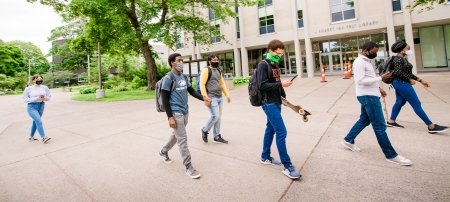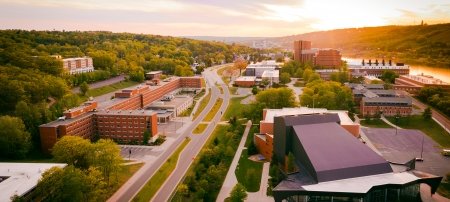For some, the pandemic’s early days were an inconvenience. For many, jobs, projects, methodologies and support systems remain uncertain. But solutions, creativity and hope vary, too.
The start of a semester often brings a mix of bright-eyed, bushy-tailed, overcaffeinated and overwhelmed enthusiasm. This year, our overflowing cups are tinged with many other flavors — some bitter, some sweet. With all of us breathing our own coffee breath filtered through masks and patience while we continue to navigate the COVID-19 pandemic, it’s a good opportunity to take a moment —breathe —and reflect.
We knew long before the pandemic that reflection is one of the most effective learning tools. And the lessons have come nonstop: from the first days of being alone together, to the rocks and discomfort we hit, to the empathy and bonds we built in reframed classrooms, and also in research labs, tenure and hiring, performance venues, testing facilities, field sites, and all the way down to the sewers. Even this small sample shows that the pandemic’s impacts varied widely. Nothing can shift to find more ease and grace without understanding where we’re at, as individuals and as collectives.
That’s why throughout the semester, we are dedicating Unscripted space for community members to share their personal stories about the challenges they face and the solutions they’re working on to uplift their research, scholarly work and creative endeavors. Some of our guest writers are principal investigators and some are staff who support the academic ecosystem. Watch for the series on the Unscripted blog, follow @mturesearch on Twitter and keep tabs on news, workshops and COVID-19 updates through Tech Today.
To honor all of their stories, it’s worth a look at the big picture of the pandemic’s impacts on research and scholarship across the state, nation and world. Here are some deep reads for context:
- Wide-angle lens from Pulitzer Prize-winning science writer Ed Yong: “How the Pandemic Now Ends.”
- National Academy of Science, Engineering, and Medicine (NASEM) report and Chronicle of Higher Education article showing disproportionately negative pandemic impacts for some researchers, notably women and people of color.
- Resources, guidelines, FAQs, factsheets and blog posts from the National Science Foundation’s Coronavirus Information page.
- Also from NSF’s toolbox: The “missing millions” in the STEM labor workforce explained in an opinion article in The Hill.
- The Chronicle of Higher Education’s take on “The Semester of Magical Thinking.”
Keep tabs on Tech Today for webinars, lunch-and-learn sessions, workshops and other resources from the Provost’s Office and Office of the Vice President for Research. Together we can reflect and learn, working through the challenges and varied impacts to enact solutions that help the whole community.
Michigan Technological University is an R1 public research university founded in 1885 in Houghton, and is home to nearly 7,500 students from more than 60 countries around the world. Consistently ranked among the best universities in the country for return on investment, Michigan's flagship technological university offers more than 185 undergraduate and graduate degree programs in science and technology, engineering, computing, forestry, business, health professions, humanities, mathematics, social sciences, and the arts. The rural campus is situated just miles from Lake Superior in Michigan's Upper Peninsula, offering year-round opportunities for outdoor adventure.






Comments